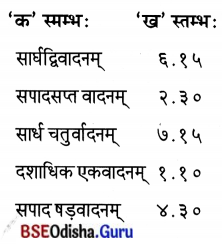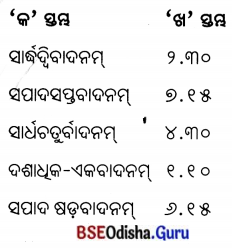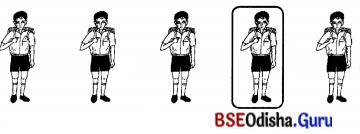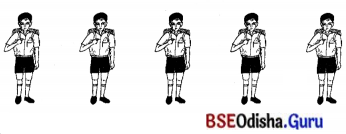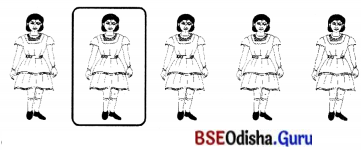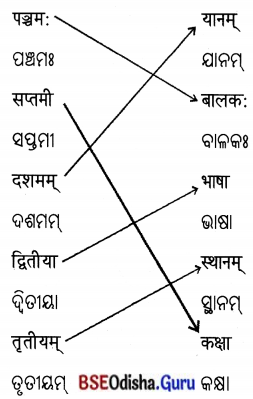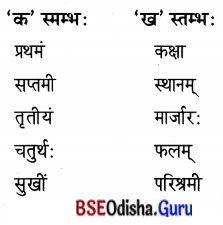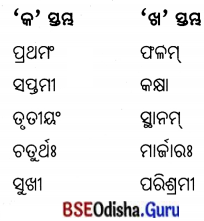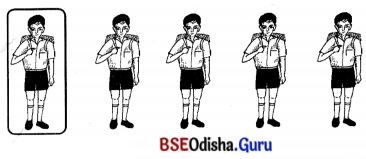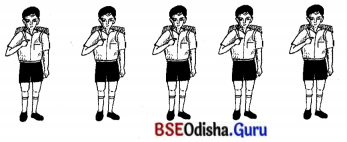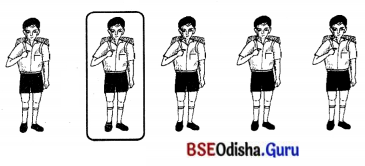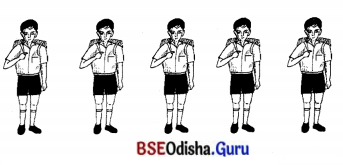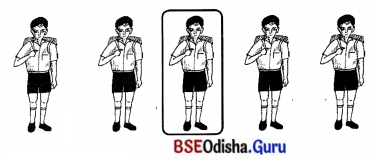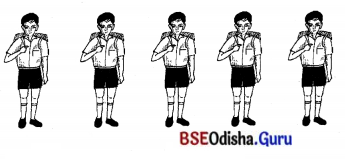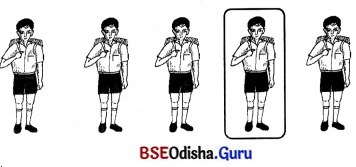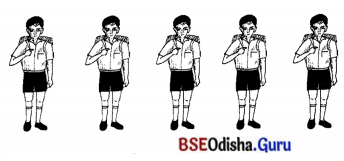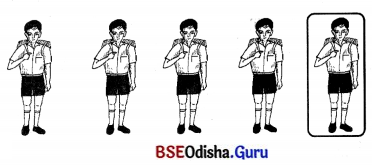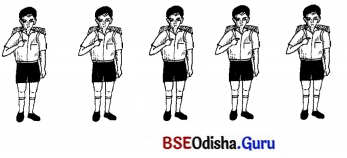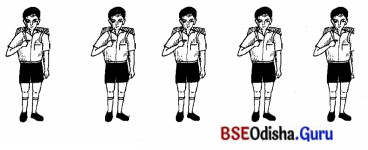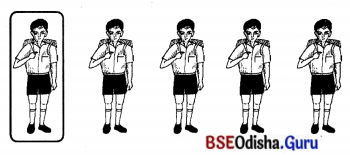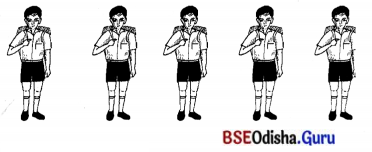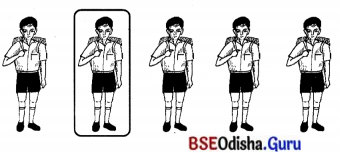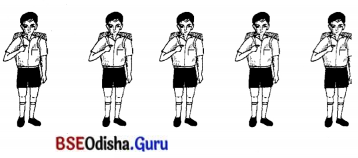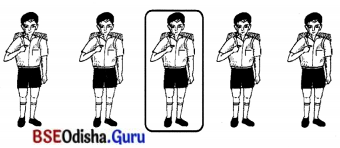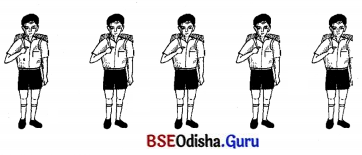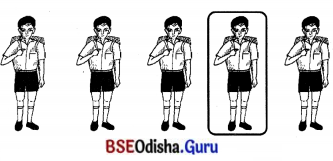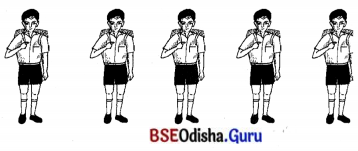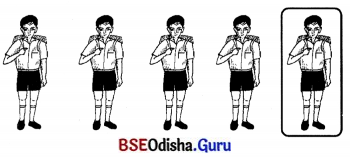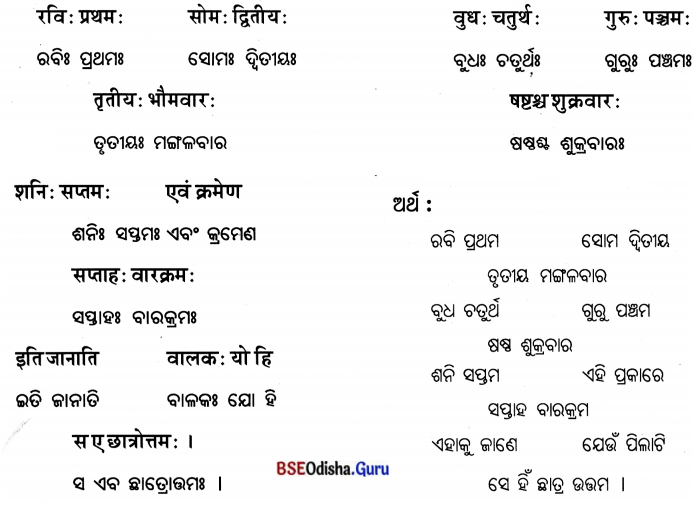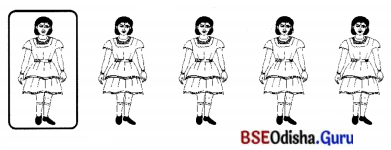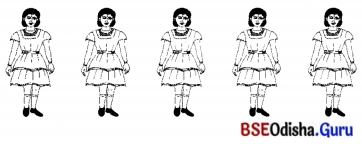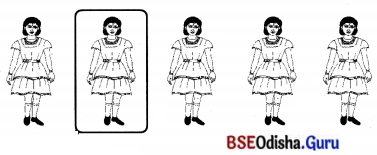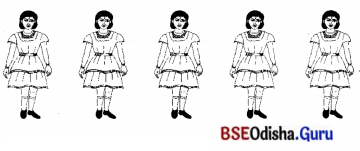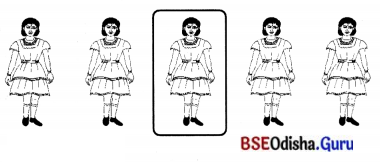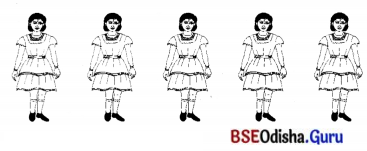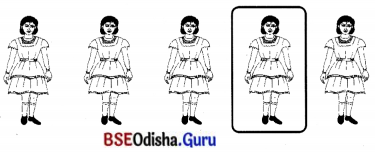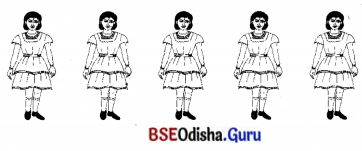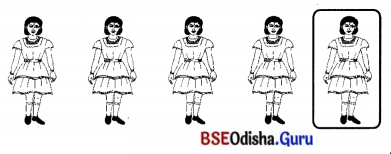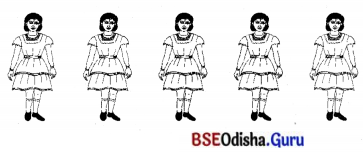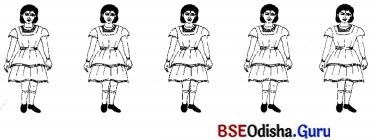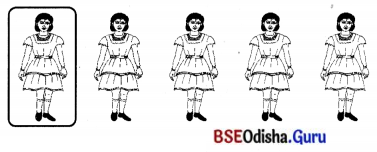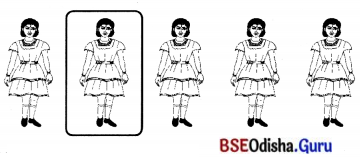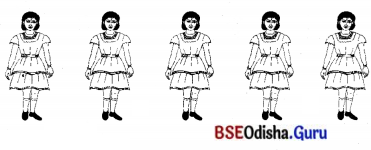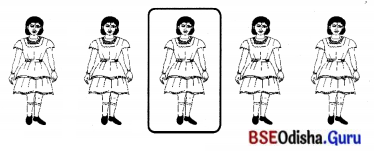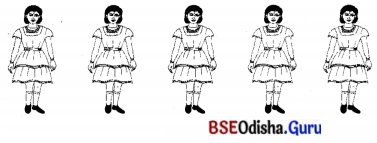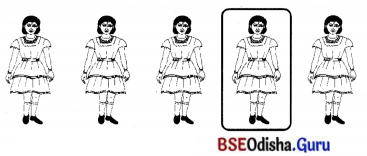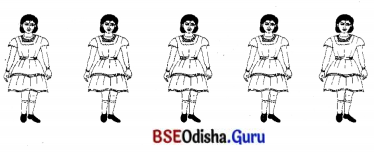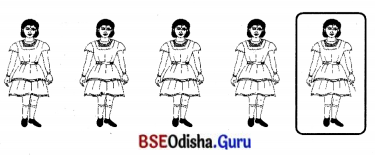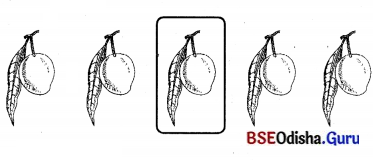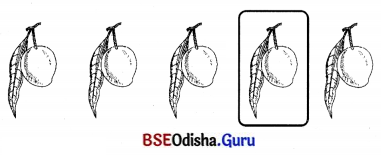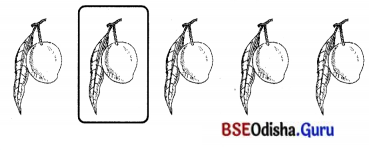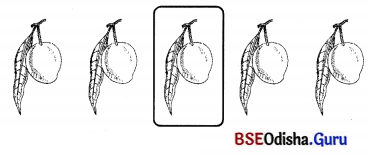Odisha State Board CHSE Odisha Class 12 Education Solutions Chapter 12 Universalization of Elementary Education (UEE) and RTE Motivation Questions and Answers.
CHSE Odisha 12th Class Education Chapter 12 Question Answer Universalization of Elementary Education (UEE) and RTE
Group – A
Short type Questions with Answers
I. Answer with in Two/Three sentence:
Question 1.
What is the primary aim of Universalisation of Elementary Education (U.E.E.) in India?
Answer:
U.E.E. aims to make elementary education available to all children in the age group of 6-14, ensuring inclusivity and eliminating dropouts.
Question 2.
Explain the significance of Sarva Shiksha Abhiyan (SSA) in India’s education system. Answer: SSA is a community-owned initiative to universalize elementary education, responding to the demand for quality basic education and fostering human capabilities.
Question 3.
What were the main objectives of Operation Blackboard, implemented in 1987 ? Answer: Operation Blackboard aimed to improve the quality of primary education by providing at least two classes in each primary school, special toilets for boys and girls, and appointing at least fifty percent female teachers.
Question 4.
Why was the District Primary Education Programme (DPEP) initiated in 1994?
Answer:
DPEP was started to revive the primary education system and achieve the universalization of primary education, focusing on enrollment, retention, and reducing inequalities among social groups.
Question 5.
What is the essential goal of the Mid-Day Meal Scheme launched in 1995?
Answer:
The Mid-Day Meal Scheme’s primary objective is to address the nutritional needs of primary school children, aiming to improve enrollment, attendance, and retention in schools.
![]()
Question 6.
Explain the primary focus of the Rashtriya Madhyamik Shiksha Abhiyan (RMSA) launched in 2009.
Answer:
RMSA aims to raise the minimum level of education till class X, with a focus on improving secondary education quality, especially in Science, Mathematics, and English.
Question 7.
Define the term ‘free education’ according to the Right to Education (RTE) Act 2009.
Answer:
‘Free education’ under the RTE Act means education without fees or charges, ensuring that no child is deprived of elementary
education due to financial constraints.
Question 8.
What is the age group covered by the RTE Act for providing free and compulsory education?
Answer:
The RTE Act provides free and compulsory education for children in the age group of 6-14 years.
Question 9.
Which article of the Indian Constitution is associated with the Right to Education?
Answer:
The Right to Education is associated with Article 21A of the Indian Constitution.
Question 10.
What does SSA stand for, and what is its primary objective?
Answer:
SSA stands for Sarva Shiksha Abhiyan,.and its primary objective is to universalize elementary education through community ownership of the school system.
II. Answer with in Five/Six sentence :
Question 1.
What is Universalisation of Elementary Education (U.E.E.) and what age group does it primarily target?
Answer:
Universalisation of Elementary Education (U.E.E.) is an inclusive approach to providing education to all children, regardless of their background. Focused on the age group of 6-14 years, it emphasizes the right of every child to receive education, considering factors such as socioeconomic status, caste, creed, and physical abilities. This concept affirms that education is. a fundamental right accessible to all children, whether residing in urban or rural areas. It underscores the idea that education should not be limited to a select few but should be universally available, ensuring equal opportunities for every child.
Question 2.
Explain the three stages involved in the Universalisation of Elementary Education.
Answer:
The Universalisation of Elementary Education unfolds through three pivotal stages. The first stage, Universalisation of Provision, focuses on establishing the necessary infrastructure and resources to facilitate elementary education. The second stage, Universalisation of Enrolment, aims to ensure that all eligible thildren are enrolled in schools, emphasizing inclusivity. Finally the third stage, Universalisation of Retention, addresses the need to retain students, minimizing dropouts and ensuring the completion of elementary education. Together, these stages form a comprehensive approach to make elementary education universally accessible, addressing both the provision of resources and the enrollment and retention of students.
Question 3.
What were the main objectives of Operation Blackboard, and how did it contribute to improving primary education in India?
Answer:
Operation Blackboard, launched in 1987, aimed at elevating the quality of primary education in India. Its primary objectives included improving infrastructure, reducing wastage and stagnation, attracting more children (especially girls) to primary education, and ensuring equitable resource distribution. By mandating at least two classrooms in each primary school, constructing gender-specific toilets, and appointing a considerable number of female teachers, Operation Blackboard significantly contributed to enhancing the accessibility and quality of primary education. The initiative strategically addressed key challenges, laying the groundwork for a more inclusive and improved primary education system.
![]()
Question 4.
What was the District Primary Education Programme (DPEP), and what were its main goals?
Answer:
Launched in 1994, the District Primary Education Programme (DPEP) in India had the overarching goal of revitalizing and universalizing primary education. DPEP adopted a universal approach, striving to enhance retention and learning achievements while minimizing disparities among various social groups. The program aimed to ensure access to primary education for all children through both formal and non-formal streams. It specifically targeted reducing differences in enrollment, dropout rates, and knowledge attainment among different genders and socio-economic groups. DPEP also sought to decrease overall dropout rates, achieve basic literacy and numeracy competencies, and elevate the average achievement rate by 25%, measured against baseline levels.
Question 5.
Explain the essential objectives and impact of the Mid-Day Meal Scheme in India.
Answer:
The Mid-Day Meal Scheme, introduced in 1995, had a fundamental objective of improving the efficiency of elementary education by addressing the nutritional needs of primary school children. Initially implemented in selected blocks, the scheme later expanded nationwide. Its primary focus was to provide a nutritious mid-day meal to all children enrolled in classes 1 to 5, with si’bsp-<uent inclusion of educationally backward classes in upper primary classes. The scheme anticipated positive outcomes such as increased enrollment, improved attendance, and enhanced retention by addressing the nutritional aspect of students. By ensuring students’ well-being, the Mid-Day Meal Scheme played a pivotal role in supporting their educational journey.
Question 6.
Highlight the key objectives and financing pattern of the Rashtriya Madhyamik Shiksha Abhiyan (RMSA) in India.
Answer:
Launched in 2009-10, the Rashtriya Madhyamik Shiksha Abhiyan (RMSA) in India had primary objectives centered around raising the minimum level of education till class X and ensuring the comprehensive development of secondary education. The financing pattern of RMSA, with a ratio of 75:25 between the Center and the States, underscored the collaborative approach to improving secondary education. The scheme specifically concentrated on enhancing the quality of education in key subjects like Science, Mathematics^ and English. Additionally, RMSA aimed to reduce gender, social, and regional disparities by focusing on improving enrollment, reducing dropout rates, and enhancing overall retention in secondary education.
Question 7.
Describe the significance and objectives of Sarva Shiksha Abhiyan (SSA) in India.
Answer:
Launched in 2001, Sarva Shiksha Abhiyan (SSA) stands as a flagship program in India, symbolizing the nation’s commitment to Universal Elementary Education (UEE). The primary objectives of SSA revolve around bridging educational disparities by providing free and compulsory education to all children aged 6 to 14. This initiative represents a significant step toward fulfilling the constitutional mandate of the Right to Education (RTE) Act, 2009. SSA aims to ensure universal access and enrollment, reduce gender and social category gaps, achieve satisfactory learning outcomes in eight years of elementary schooling, promote inclusive education practices, and enhance overall education quality through infrastructure development and teacher training.
![]()
Question 8.
What are the main objectives of Samagra Shiksha Abhiyan (SSA) in India, and how does it differ from Sarva Shiksha Abhiyan (SSA)?
Answer:
Samagra Shiksha Abhiyan (SSA), introduced in 2018, is an integrated scheme for school education in India, differing from Sarva Shiksha Abhiyan (SSA) in its comprehensive approach. SSA subsumes three existing schemes – Sarva Shiksha Abhiyan (SSA), Rashtriya Madhyamik Shiksha Abhiyan (RMSA), and Teacher Education (TE). The primary objectives of SSA include providing holistic education from pre-school to class 12, ensuring equal access to education, improving quality, promoting inclusive education, and emphasizing teacher development. Unlike SSA, which primarily focuses on elementary education, Samagra Shiksha Abhiyan (SSA) takes an integrated approach, covering both elementary and secondary education along with teacher education.
Question 9.
Explain the key components and implementation strategies of Sarva Shiksha Abhiyan (SSA) in India.
Answer:
Sarva Shiksha Abhiyan (SSA) in India operates through a set of key components and implementation strategies to achieve its objectives comprehensively. Universal enrollment ensures that all children in the target age group are enrolled in schools, promoting inclusivity. Infrastructure development is a critical component, focusing on improving school facilities, including classrooms, drinking water, and sanitation.
Quality improvement strategies include teacher training, the development of teaching materials, and the introduction of innovative teaching methods to enhance the overall quality of education. Inclusive education is a prominent aspect, emphasizing the mainstreaming of children from marginalized communities and those with special needs. Community participation is actively encouraged, involving local communities, parents, and Panchayati Raj Institutions in the planning and implementation of educational initiatives.
Question 10.
What are the key features of the Right to Education (RTE) Act 2009, and how does it contribute to ensuring elementary education for every child in India?
Answer:
The Right of Children to Free and Compulsory Education (RTE) Act 2009 is a significant legislative framework that contributes to ensuring elementary educatnn for every child in India. The key features include recognizing the right of every child to full-time oasic education of adequate and equitable quality. The act imposes a legal obligation on the Central and State Governments to provide free and compulsory education, ensuring admission, attendance, and completion of elementary education for every child in the 6-14 age group. The RTE Act prohibits any form of fee or charge that could impede a child’s access to education. Furthermore, it outlines responsibilities, allocates financial and other duties, establishes standards, and promotes a cl ld-centrie le^ anc environment, playing a pivotal role in realizing the vision of elementary educa’ion for all.
Group – B
Long Type Questions With Answers
Question 1.
What is the concept and significance of elementary education?
Answer:
Elementary education is the initial phase of formal education that focuses on providing foundational learning to children typically in the age group of 6 to 14 years. It forms the basis for intellectual, social, and emotional development, setting the stage for a child’s lifelong learning journey.Elementary education encompasses the basic principles and skills necessary for a child’s intellectual growth. It typically includes subjects like language arts, mathematics, science, and social studies. The curriculum is designed to be age-appropriate, recognizing the cognitive abilities and learning needs of children in this stage. The learning methodologies emphasize interactive and experiential approaches to make education engaging and effective.
The concept of elementary education extends beyond the formal classroom setting. It acknowledges the diversity of learners and recognizes the importance of addressing individual learning styles. Moreover, it encompasses not only academic knowledge but also essential life skills, values, and attitudes that contribute to holistic development.
Significance:
• Foundation for Learning: Elementary education lays the groundwork for advanced learning. It introduces fundamental concepts, such as reading, writing, and arithmetic, that serve as building blocks for higher education.
• Cognitive Development: This stage is crucial for cognitive development, as children begin to think abstractly, solve problems, and develop critical thinking skills. Exposure to various subjects contributes to the development of a well-rounded intellect.
• Socialization and Interaction : Elementary education provides a structured environment for socialization. Children learn to interact with peers, teachers, and other members of the school community, fostering social skills and emotional intelligence.
• Inclusivity : The significance of elementary education lies in its commitment to inclusivity. It aims to provide education to children from diverse backgrounds, regardless of socioeconomic status, gender, or physical abilities.
• Preparation for Lifelong Learning : Elementary education instills a love for learning and curiosity. It equips students with the skills and motivation needed to pursue continuous learning throughout their lives.
• Community Development: By fostering a sense of community within schools, elementary education contributes to the overall development of society. Schools become hubs for collaboration, cultural exchange, and collective growth.
• Equal Opportunities : It addresses disparities by ensuring that aU children, irrespective of
their background, have access to quality education. This contributes to breaking the cycle of poverty and promoting social equity. .
• Personal and Ethical Development: Elementary education plays a vital role in shaping students’ character, instilling values, and promoting ethical behavior. It contributes to the development of responsible and conscientious citizens.
In conclusion, elementary education serves as the cornerstone of an individual’s educational journey. Its concept revolves around providing a comprehensive learning experience, while its significance extends to shaping the future citizens of a society, fostering inclusivity, and laying the foundation for a lifetime of learning.
![]()
Question 2.
What are the primary objectives of elementary education?
Answer:
Elementary education plays a pivotal role in shaping the intellectual, social, and emotional development of children. The primary objectives of elementary education are multifaceted, aiming to provide a strong foundation for lifelong learning and holistic development.
Foundational Learning : One of the central objectives of elementary education is to impart foundational knowledge and skills. This includes basic literacy, numeracy, and critical thinking abilities that form the basis for further academic pursuits.
Cognitive Development: Elementary education is designed to stimulate cognitive development during the crucial formative years. It focuses on enhancing, a child’s ability to comprehend, analyze, and synthesize information, laying the groundwork for higher-order thinking.
Socialization : An essential objective is to foster socialization. Children learn to interact with peers, teachers, and the broader school community. This social exposure contributes to the development of interpersonal skills, teamwork, and a sense of belonging.
Inclusive Education : Elementary education aims to be inclusive, ensuring that all children, regardless of socio-economic status, gender, or physical abilities, have equal access to quality education. Inclusivity promotes diversity and prepares children for a globalized world.
Holistic Development: The holistic development of a child is a key objective. Beyond academic knowledge, elementary education addresses emotional, physical, and creative aspects. It nurtures talents, creativity, and emotional intelligence.
Preparation for Higher Education : Elementary education serves as a preparatory phase for higher levels of education. It equips students with the academic skills and knowledge necessary for more advanced studies, providing a seamless transition to secondary education.
Cultural and Ethical Values : Instilling cultural and ethical values is an integral objective. Elementary education plays a role in shaping character, morality, and ethical behavior. It contributes to the development of responsible and conscientious citizens.
Self-Efficacy and Confidence : Building self-efficacy and confidence is crucial. Elementary education should create an environment where children feel empowered to explore, express their opinions, and take on challenges, fostering a positive self-image.
Promotion of Curiosity and Love for Learning : Elementary education aims to nurture curiosity and a love for learning. It seeks to create an environment where children are naturally inclined to explore, ask questions, and engage actively in the learning process.
Equity and Access : Ensuring equity in education is a fundamental objective. Elementary education strives to bridge socio-economic gaps, providing equal opportunities for education to children from diverse backgrounds. Parental and Community Involvement: Collaboration between educators, parents, and the community is emphasized. Elementary education aims to create a supportive network involving parents and the community, recognizing their role in a child’s educational journey.
Prevention of Dropout: Another crucial objective is the prevention of dropout rates. Elementary education initiatives should implement strategies to reduce dropout rates, ensuring that children complete the recommended years of primary education. In conclusion, the primary objectives of elementary education are comprehensive, addressing academic, social, and personal development. By focusing on these objectives, elementary education contributes significantly to shaping well-rounded individuals capable of navigating the challenges of the future.
Question 3.
“How does the concept of Universalisation of Elementary Education (UEE) manifest in India, and what initiatives and challenges are associated with ensuring free and compulsory education for all children in the age group of 6-14 years ?”
Answer:
The concept of Universalisation of Elementary Education (UEE) in India embodies the commitment to provide free and compulsory education for all children aged 6-14 years. This ambitious initiative reflects a foundational belief that education is a fundamental right and a crucial tool for national development. The manifestation of UEE in India involves a multi-faceted approach, accompanied by various initiatives and challenges.
Initiatives:
- Sarva Shiksha Abhiyan (SSA): Launched in 2001, SSA is a flagship program aimed at achieving UEE. It focuses on universal access and enrollment, emphasizing the inclusion of marginalized groups and addressing gender and social gaps in education.
- Operation Blackboard : Introduced in 1987, Operation Blackboard aimed at improving the quality of primary education. It focused on essential infrastructure development, including classrooms, separate toilets for girls and boys, and the appointment of female teachers.
- Mid-Day Meal Scheme (MDM) : The MDM program, initiated in 1995, addresses the nutritional aspect of elementary education. By providing free mid-day meals, it aims to improve the effectiveness of elementary education by enhancing the dietary status of children.
- District Primary Education Programme (DPEP): Launched in 1994, DPEP aimed to revitalize the primary education system. It adopted a universal approach, focusing on improving retention, learning achievements, and reducing inequalities among social groups.
- Rashtriya Madhyamik Shiksha Abhiyan (RMSA): Introduced in 2009-10, RMSA focuses on extending the UEE objectives to secondary education. It emphasizes quality secondary education with a specific focus on Science, Mathematics, and English.
Challenges :
- Infrastructure Disparities : Disparities in infrastructure development persist across regions, affecting the overall quality of education. Remote and economically disadvantaged areas often face challenges in accessing adequate facilities.
- Teacher Shortages : Shortages of qualified teachers in certain areas hinder the effective implementation of UEE. Ensuring a sufficient number of trained educators remains a persistent challenge.
- Quality of Learning Outcomes : While enrollment rates have increased, ensuring that students receive quality education with satisfactory learning outcomes poses a significant challenge. The focus needs to shift from mere enrollment to ensuring meaningful learning experiences.
- Equitable Access : Despite efforts, ensuring equitable access to education for children from marginalized communities, girls, and those with special needs remains an ongoing challenge. Socio-economic factors and cultural norms can hinder participation.
- Parental Involvement: While community participation is encouraged, achieving active parental involvement in the educational process poses challenges. Socio-economic conditions and lack of awareness can impact parents’ engagement in their children’s education.
- Dropout Rates : Prevention of dropout rates is crucial for the success of UEE. Various socio-economic factors, including poverty and the need for child labor, contribute to children leaving the education system prematurely.
Implications :
The successful realization of UEE in India holds profound implications for the nation’s future. It can lead to a more literate and skilled population, fostering economic growth, social development, and greater inclusivity. However, addressing the challenges requires a concerted effort from policymakers, educators, and communities to ensure that the vision of UEE translates into tangible and lasting benefits for every child in the age group of 6-14 years.
![]()
Question 4.
“How does the Right to Education Act (RTE) in India, enacted in 2009, serve as a transformative legal framework to ensure free and compulsory education, addressing disparities and promoting inclusive, quality elementary education for every child in the age group of 6 to 14 years across the nation ?”
Answer:
• The Right to Education Act (RTE) enacted in India in 2009 stands as a transformative legal framework, marking a significant milestone in the country’s commitment to providing accessible, inclusive, and quality elementary education for every child aged 6 to
14. This comprehensive legislation addresses various aspects of education, focusing on eliminating disparities, ensuring free and compulsory education, and promoting inclusivity.
• At its core, the RTE Act is a constitutional provision that recognizes education as a fundamental right, thereby establishing a legal obligation on the part of the government to make elementary education free and compulsory. The enactment of this legislation was a response to the need for a structured and rights-based approach to education, aiming to bridge socio-economic gaps and create a level playing field for all children.
• The Act’s primary objective is to eradicate barriers that prevent children from accessing education, especially those from marginalized and economically disadvantaged backgrounds. By mandating free education for all children in the specified age group, the RTE Act addresses financial constraints that often hinder families from sending their children to school. This provision ensures that education is not a privilege limited to certain sections of society but a universal right available to every child.
• Moreover, the RTE Act goes beyond mere access to education; it emphasizes the quality and inclusivity of the educational experience. The legislation recognizes the diverse needs of children, including those with disabilities and from socially marginalized communities, promoting inclusive education practices. It mandates the creation of an environment that caters to the specific requirements of children with disabilities, ensuring their integration into mainstream educational settings.
• The Act also tackles issues related to infrastructure, teacher-student ratios, and the overall quality of education. It mandates the provision of essential facilities in schools, such as classrooms, libraries, and playgrounds, contributing to a conducive learning environment. Additionally, the RTE Act outlines guidelines for teacher recruitment, training, and workload, aiming to enhance the quality of teaching and, consequently, the overall educational experience.
• By establishing a legal framework for elementary education, the RTE Act holds governments accountable for the effective implementation of these provisions. It delineates the roles and responsibilities of various stakeholders, including central and state governments, local authorities, and parents, in ensuring the fulfillment of the right to education. The Act introduces mechanisms for monitoring and redressal, allowing individuals to seek legal remedies in case of violations or non-compliance.
• In essence, the Right to Education Act in India is a visionary piece of legislation that not only recognizes education as a fundamental right but also envisions a holistic and inclusive approach to elementary education. As a transformative legal framework, it strives to create a foundation for a more equitable and enlightened society by ensuring that every child has the opportunity to receive quality education, irrespective of socio-economic background or other barriers.
Group – C
Objective type Questions with Answers
I. Multiple Choice Questions with Answers :
Question 1.
What does U.E.E. stand for in the context of education in India?
(i) Universal Education and Excellence
(ii) Universalisation of Elementary Education
(iii) United Educational Endeavors
(iv) Uniformity in Educational Excellence
Answer:
(ii) Universalisation of Elementary Education
Question 2.
At what age group does Universalisation of Elementary Education (U.E.E.) aim to provide education?
(i) 3-8 years
(ii) 6-14 years
(iii) 10-18 years
(iv) 12-16 years
Answer:
(ii) 6-14 years
Question 3.
What is the primary focus of Universalisation of Elementary Education?
(i) Secondary education for all
(ii) Tertiary education for all
(iii) Elementary education for all children
(iv) Higher education for selected individuals
Answer:
(iii) Elementary education for all children
Question 4.
Which act serves as the cornerstone of U.E.E. and emphasizes free and compulsory education for all children aged 6 to 14 years?
(i) National Policy on Education (NPE)
(ii) Right to Education (RTE) Act
(iii) Sarva Shiksha Abhiyan (SSA)
(iv) District Primary Education Programme (DPEP)
Answer:
(ii) Right to Education (RTE) Act
![]()
Question 5.
What are the three stages involved in the Universalisation of Elementary Education?
(i) Provision, Enrolment, and Retention
(ii) Access, Quality, and Inclusivity
(iii) Infrastructure, Teacher Training, and Curriculum
(iv) Primary, Secondary, and Tertiary ‘
Answer:
(i) Provision, Enrolment, and Retention
Question 6.
Sarva Shiksha Abhiyan (SSA). is an effort to universalize elementary education by:
(i) Centralized control
(ii) Community ownership of the school system
(iii) Privatization of schools
(iv) Teacher-driven initiatives
Answer:
(ii) Community ownership of the school system
Question 7.
Operation Blac kboard, implemented in 1987, aimed at:
(i) Promoting sports in schools
(ii) Improving the quality of primary education
(iii) Establishing vocational training centers
(iv) Enhancing art and cultural education
Answer:
(ii) Improving the quality of primary education
Question 8.
What was the primary focus of Operation Blackboard?
(i) Providing two classes in each primary school
(ii) Constructing special toilets for girls and boys
(iii) Appointing at least fifty percent female teachers
(iv) All of the above
Answer:
(iv) Ail of the above
Question 9.
District Primary Education Programme (DPEP) was initiated in:
(i) 1986
(ii) 1994
(iii) 2001
(iv) 2009
Answer:
(ii) 1994
Question 10.
What is the main aim of DPEP?
(i) Improving secondary education
(ii) Ensuring universal access to higher education
(iii) Reviving and universalizing primary education
(iv) Promoting vocational education
Answer:
(iii) Reviving and universalizing primary education
![]()
Question 11.
The Mid-Day Meal Scheme was launched to:
(i) Provide financial assistance to students
(ii) Enhance the quality of elementary education
(iii) Promote extracurricular activities in schools
(iv) Address nutritional needs of primary school children
Answer:
(iv) Address nutritional needs of primary school children
Question 12.
When was the Mid-Day Meal Scheme initially launched in India?
(i) 1986
(ii) 1995
(iii) 2001
(iv) 2009
Answer:
(ii) 1995
Question 13.
The Rashtriya Madhyamik Shiksha Abhiyan (RMSA) was launched in:
(i) 1990
(ii) 2001
(iii) 2009
(iv) 2018
Answer:
(iii) 2009
Question 14.
What is the financing pattern of the RMSA scheme between the Center and the States?
(i) 50:50
(ii) 75:25
(iii) 80:20
(iv) 60:40
Answer:
(ii) 75:25
Question 15.
What is the main objective of the Rashtriya Madhyamik Shiksha Abhiyan (RMSA)?
(i) Universalization of elementary education
(ii) Raising the minimum level of education till class X
(iii) Promoting vocational education
(iv) Enhancing the quality of higher education
Answer:
(ii) Raising the minimum level of education till class X
![]()
Question 16.
Sarva Shiksha Abhiyan (SSA) in India covers education from:
(i) Pre-school to class 5
(ii) Pre-school to class 8
(iii) Pre-school to class 12
(iv) Pre-school to university level
Answer:
(iii) Pre-school to class 12
Question 17.
What is the primary focus of the Quality Improvement component under SSA?
(i) Infrastructure development
(ii) Teacher training
(iii) Digital initiatives
(iv) Vocational education
Answer:
(ii) Teacher training
Question 18.
The Right to Education (RTE) Act 2009 became effective on:
(i) April 1,2000
(ii) April 1,2010
(iii) January 1, 2009
(iv) January 1, 2010
Answer:
(ii) April 1, 2010
Question 19.
According to the RTE Act, what does ‘free education’ mean?
(i) Education without any rules
(ii) Education without exams
(iii) Education without fees or charges
(iv) Education without teachers
Answer:
(iii) Education without fees or charges
![]()
Question 20.
What is the age group covered by the RTE Act for providing free and compulsory education?
(i) 3-10 years
(ii) 6-14 years
(iii) 10-18 years
(iv) 12-16 years
Answer:
(ii) 6-14 years
Question 21.
Which article of the Indian Constitution is associated with the Right to Education?
(i) Article 21
(ii) Article 41
(iii) Article 51A
(iv) Article 15
Answer:
(iii) Article 21A
Question 22.
The RTE Act prohibits the employment of teachers for non-educational work, except for:
(i) Sports events
(ii) Decennial census
(iii) Cultural festivals
(iv) Political campaigns
Answer:
(ii) Decennial census.
Question 23.
What does SSA stand for?
(i) Sarva Shiksha Act
(ii) Sustainable School Abhiyan
(iii) Sarva Shiksha Abhiyan
(iv) Secondary School Association
Answer:
(iii) Sarva Shiksha Abhiyan
Question 24.
Which initiative is aimed at reducing gender, social, and regional disparities in secondary education?
(i) DPEP
(ii) SSA
(iii) RMSA
(iv) RTE
Answer:
(iii) RMSA
Question 25.
The Rashtriya Madhyamik Shiksha Abhiyan (RMSA) emphasizes improving education with a focus on:
(i) History and Geography
(ii) Science, Mathematics, and English
(iii) Arts and Humanities
(iv) Vocational subjects
Answer:
(ii) Science, Mathematics, and English
II. Fill in the blanks :
Question 1.
U.E.E. stands for in the context of education in India.
Answer:
Universalisation of Elementary Education
Question 2.
Universalisation of Elementary Education aims to provide education, to children in the age group of .
Answer:
6-14 years
Question 3.
Sarva Shiksha Abhiyan (SSA) focuses on universalizing elementary education through
Answer:
community ownership of the school system
Question 4.
Operation Blackboard, implemented in 1987, aimed at imprbving the of primary education.
Answer:
quality
![]()
Question 5.
District Primary Education Programme (DPEP) was initiated in to revive and universalize primary education.
Answer:
1994
Question 6.
The Mid-Day Meal Scheme was launched in India to address the of primary school children.
Answer:
nutritional needs
Question 7.
Rashtriya Madhyamik Shiksha Abhiyan (RMSA) was launched with a financing pattern of between the Center and the States.
Answer:
75:25
Question 8.
The Right to Education (RTE) Act 2009 became effective on .
Answer:
April 1, 2010
Question 9.
According to the RTE Act, ‘free education’ means education without any .
Answer:
fees or charges
![]()
Question 10.
The age group covered by the RTE Act for providing free and compulsory education is
Answer:
6-14 years
Question 11.
SSA covers education from pre-school to .
Answer:
class 1
Question 12.
The primary focus of the Quality Improvement component under SSA is .
Answer:
teacher training
Question 13.
Samagra Shiksha Abhiyan (SSA) subsumes three existing schemes, namely SSA, RMSA, and .
Answer:
Teacher Education (TE)
Question 14.
SSA aims to provide holistic education, addressing pre-school to .
Answer:
class 12
![]()
Question 15.
The Right to Education (RTE) Act was implemented in India in response to the constitutional mandate of .
Answer:
Article
Question 16.
The RTE Act prohibits the employment of teachers for non-educational work, except for
Answer:
decennial census
Question 17.
Samagra Shiksha Abhiyan (SSA) promotes the integration of in education.
Answer:
technology
Question 18.
SSA focuses on improving school infrastructure, including the construction of classrooms, libraries, laboratories, and facilities.
Answer:
toilet
Question 19.
SSA emphasizes the professional development of teachers through various programs.
Answer:
training
Question 20.
The RTE Act places an obligation on the appropriate Government and local authorities to ensure admission, attendance, and completion of elementary education by all children in the age group.
Answer:
6-14 years
II. Correct the Sentences :
Question 1.
Universalisation of Elementary Education (U.E.E.) aims to make education available to all children in the age group of 3-10 years.
Answer:
Universalisation of Elementary Education (U.E.E.) aims to make education available to all children in the age group of 6-14 years.
Question 2.
Operation Blackboard, implemented in 1987, aimed at constructing special toilets for girls and boys in primary schools.
Answer:
Operation Blackboard, implemented in 1987, aimed at improving the quality of primary education and providing at least two classes in each primary school.
Question 3.
District Primary Education Programme (DPEP) was initiated in 2001 to improve secondary education.
Answer:
District Primary Education Programme (DPEP) was initiated in 1994 to revive and universalize primary education.
Question 4.
The Mid-Day Meal Scheme was launched in 2007 with the aim of improving enrollment, presence, and retention of children in schools.
Answer:
The Mid-Day Meal Scheme was launched in 1995 with the aim of improving the nutritional status of children in primary schools.
Question 5.
Rashtriya Madhyamik Shiksha Abhiyan (RMSA) became effective in 2010 with a financing pattern of 50:50 between the Center and the States.
Answer:
Rashtriya Madhyamik Shiksha Abhiyan (RMSA),was launched in 2009-10 with a financing pattern of 75:25 between the Center and the States.
![]()
Question 6.
Sarva Shiksha Abhiyan (SSA) was launched in 2001 as a response to the demand for quality higher education.
Answer:
Sarva Shiksha Abhiyan (SSA) was launched in 2001 as an effort to universalize elementary education by community ownership of the school System.
Question 7.
The Right to Education (RTE) Act 2009 came into effect on January 1, 2010.
Answer:
The Right to Education (RTE) Act 2009 came into effect on April 1, 2010.
Question 8.
RTE Act prohibits the employment of teachers for non-educational work, except for cultural festivals.
Answer:
RTE Act prohibits the employment of teachers for non-educational work, except for decennial census, elections, and tragedy assistance.
Question 9.
Samagra Shiksha Abhiyan (SSA) is an independent scheme launched in 2018, separate from Sarva Shiksha Abhiyan (SSA).
Answer:
Samagra Shiksha Abhiyan (SSA) is an integrated scheme launched in 2018, subsuming Sarva Shiksha Abhiyan (SSA) and Rashtriya Madhyamik Shiksha Abhiyan (RMSA).
Question 10.
The Right to Education (RTE) Act 2009 specifies the responsibility of parents in providing appropriate and firee compulsory education.
Answer:
The Right to Education (RTE) Act 2009 specifies the responsibility of parents, governments, and local authorities in providing appropriate and free compulsory education.
II. Answer the following questions in one word :
Question 1.
What does U.E.E. stand for in education?
Answer:
Universalisation of Elementary Education
Question 2.
At what age group does U.E.E. aim to provide education?
Answer:
6-14 years ,
Question 3.
What are the three stages involved in U.E.E.?
Answer:
Provision, Enrolment, Retention
Question 4.
Which act emphasizes free and compulsory education for children aged 6 to 14 years?
Answer:
RTE Act
Question 5.
Which initiative focuses on community ownership of the school system?
Answer:
Sarva Shiksha Abhiyan (SSA)
Question 6.
Which scheme aimed at improving the quality of primary education and reducing dropouts?
Answer:
Operation Blackboard
![]()
Question 7.
When was the Mid-Day Meal Scheme initially launched in India?
Answer:
1995
Question 8.
What is the financing pattern of the Rashtriya Madhyamik Shiksha Abhiyan (RMSA)?
Answer:
75:25 (Center:States)
Question 9.
Which article of the Indian Constitution is associated with the Right to Education?
Answer:
Article 21A
Question 10.
What ddes ‘free education’ mean according to the RTE Act?
Answer:
Education without fees or charges
Question 11.
What is the age group covered by the RTE Act for providing free and compulsory education?
Arts.
6-14 years
Question 12.
Which scheme was launched in 2018 and integrates three existing education schemes?
Answer:
Samagra Shiksha Abhiyan (SSA)
Question 13.
Which program emphasizes equal access to education and improving quality?
Answer:
Samagra Shiksha Abhiyan (SSA)
![]()
Question 14.
What does the Right to Education (RTE) Act prohibit teachers from participating in, except for specific events?
Answer:
Decennial census
Question 15.
Which act became effective on April 1, 2010, ensuring free and compulsory education for children?
Answer:
RTE Act 2009
Universalisation of elementary education and right to education:
Universalisation of Elementary Education (U.E.E.) is an educational term refers to make education available to all children in the age of group of 6-14 or in classes I-VII. It means the education for every child .to complete the stage of Elementary or Primary education either formal or nonformal means of education. Here all children covered the children of every community castes, creed, religions, handicapped, orphans or destitutes and disadvantaged groups. It signifies that education is for all and not for a selected few. This concept accepts that education is the birth right of every child. This means all children belonging to the rich and the poor living in towns as well as rural areas or hills and plains, which are accessible with difficulty; have to be provided with facilities for elementary education.
In short, universalisation of elementary education is the educational provision for all children to educate elementary education without any dropouts. Universalisation of elementary education also means free and compulsory elementary education for all children till they complete 14 years of age. Universalisation of Elementary Education involved the three years stages or steps, which are Universalisation of Provision, Universalisation of Enrolment, and Universalisation of Retention. Sarva Shiksha Abhiyan is an effort to universalise elementary education by community ownership of the school system. It is a response to the demand for quality basic education all over the country. The SS A programme is also an attempt to provide an opportunity for improving human capabilities to all children, through provision of community owned quality education in a mission mode.
Operation Blackboard : A scheme has been implemented by the Indian Government as per the recommendation produced by NPE during Rajiv Gandhi’s reign in 1987. The most important objectives of Operation Blackboard were improvement in the quality of primary education: Reducing rate of wastage and stagnation: To attract aU children, especially girls in primary education, so that the dream of education can be realized for all. This plan was mainly focused on providing at least two classes in each primary school; Special toilets for girls and boys; Appointing at least fifty percent female teachers of the total teachers.
District Primary Education Programme (DPEP): In order to revive primary education system and to achieve the goal of universalization of the primary education. The District Primary Education Programmme (DPEP) was started in 1994. DPEP adopted for adopting universal approach, improving retention and learning achievements and reducing inequalities among social groups. The main aims of this program are reach to primary education by formal/non-formal stream for all children, to trim down differences in enrolment of the children, drop-out rates knowledge attainment among gender and group of weaker section of the society to less than 5 per cent, to reduce dropout rates for all the children to less than 10 per cent and to rise average achievement rate 25 per cent by measured by measured baseline level and ensure attainment of basic literacy and the numeracy competencies and the minimum of forty per cent in other competencies by all primary education children.
Mid-Day Meal Scheme : Government of India was launched the National Program of nourishment Support for Primary Education (NP-NSPE) on 15th August, 1995. The essential or main objective of the scheme is to help get better the effectiveness of elementary education by improving the dietary status of children of primary school. Initially, this scheme was implement in 2,408 blocks in the country so that the students could be fed food in five sections from one to one in the schools run by food, government aided and local body. From 1997-98, the scheme of MDM was executed in all over India. Under this scheme, all the children enroll in course/class 1 to five contain a ripe Mid-Day Meal with three hundred calories and twelve grams of protein. In October 2007, in this scheme, 3,499 educationally backward classes were included in the upper primary classes from six to eight students. It was expected that MDM will improve enrolment, presence and retention of the children in schools.
The Rashtriya Madhyamik Shiksha Abhiyan (RMSA): With a financing pattern of 75:25 between the Center and the States, a scheme sponsored by the Central Government was launched in 2009-10. The most important objectives of this scheme are: (1) to raise the minimum level of education till class X and to make secondary education entire. (2) To recognize good quality secondary education with focus on Science, Mathematics and English. To (3) educing gender, social and regional interval to get better enrollment, dropout and retention (1) Sarva Shiksha Abhiyan (SSA) in India :
(1) Sarva Shiksha Abhiyan (SSA) is a flagship program in India that embodies the nation’s commitment to achieving Universal Elementary Education (UEE). Launched in 2001, SSA is a centrally sponsored scheme aimed at providing free and compulsory education toall children in the age group of 6 to 14 years. Sarva Shiksha Abhiyan, meaning ‘Education for All’ in Hindi, was introduced with the objective of bridging educational disparities and ensuring access to quality education for every child across the diverse socio-economic spectrum of India. This initiative represents a crucial step towards fulfilling the constitutional mandate of the Right to Education (RTE) Act, 2009.
The primary objectives of SSA include:
- Ensuring universal access and enrollment of all children in elementary education.
- Bridging gender and social category gaps in education.
- Ensuring that children complete eight years of elementary schooling with satisfactory learning outcomes.
- Focusing on the needs of children with special requirements through inclusive education practices.
- Enhancing the quality of education through teacher training and the provision of necessary infrastructure and learning materials.
Achievements of SSA:- Over the years, SSA has achieved significant milestones, contributing to the improvement of elementary education in India :
- Increased Enrollment: SSA has played a pivotal role in increasing enrollment rates, especially among marginalized communities and the girl child.
- Infrastructure Development: The program has led to the construction and upgrade of schools, providing better facilities for students and teachers.
- Quality Enhancement: Teacher training programs and the development of teaching materials have positively impacted the quality of education.
- Inclusive Education : SSA has contributed to fostering a more inclusive educational environment, addressing the needs of children with disabilities and those from marginalized backgrounds.
Challenges and Criticisms :- Despite its successes, SSA faces several challenges :
- Infrastructure Disparities : Disparities in infrastructure development persist across regions, affecting the overall quality of education.
- Teacher Shortages : Shortages of qualified teachers in some areas hinder the effective implementation of SSA.
- Quality of Learning Outcomes : While enrollment has increased, ensuring that students receive a quality education with satisfactory learning outcomes remains a challenge.
Sarva Shiksha Abhiyan stands as a cornerstone in India’s journey towards Universal Elementary Education. Despite challenges, its multifaceted approach has significantly contributed to increasing enrollment, improving infrastructure, and fostering inclusive education. As India continues to evolve its educational landscape, SSA remains a vital instrument in realizing the vision of education for all.
2. Samagra Shiksha Abhiyan (SSA) :
Samagra Shiksha Abhiyan (SSA) is an integrated scheme for school education in India, which was launched in 2018. It is an umbrella program that subsumes three existing schemes – Sarva Shiksha Abhiyan (SSA), Rashtriya Madhyamik Shiksha Abhiyan (RMSA), and Teacher Education (TE). The merger of these schemes aims to bring about a holistic and integrated approach to school education from pre-school to class 12.
Objectives :
- Holistic Education: SSA aims to provide holistic education, addressing not only elementary education (as in the case of SSA) but also secondary education (as in the case of RMSA) and teacher education.
- Equal Access : The scheme focuses on ensuring equal access to education, irrespective of gender, socio-economic background, or geographical location.
- Improving Quality : SSA aims to enhance the quality of education by improving infrastructure, training teachers, and introducing innovative teaching methods.
- Inclusive Education : The scheme promotes inclusive education by addressing the needs of children with special needs and other marginalized groups.
- Teacher Development: SSA emphasizes the professional development of teachers through various training programs, ultimately improving the overall quality of education.









